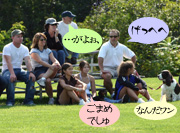
So far, I’ve spoken about verbal characters from the four perspectives of “class,” “status,” “gender,” and “age” (parts 57–72), and addressed, albeit with some digressions, the question I thought would be foremost in my readers’ minds —that of whether or not just four perspectives are enough (parts 73–82). Next I want to address the opposite question: are four perspectives too many? Let me begin by explaining the import of this question.
For example, a “vulgar, aged man of low status” character would say Gehhehe, kore de yoo, tsumi mo nai shimin o yoo, koroseru ttee sumpoo da ze! (Hee hee hee! My plan is to kill an innocent civilian!) (part 73). This verbal character’s class is “vulgar,” his status is low (or “high” or “runt”), his gender is “male,” his age is “elder.” Thus values (“vulgar,” “high or runt,” “male,” and “elder”) can be designated for the four perspectives of “class,” “status,” “gender,” and “age.” This would imply that indeed, the four perspectives of “class,” “status,” “gender,” and “age” are necessary when talking about a speaker’s character.
But what of verbal characters who pronounce the interjectory particle yo with an abrupt rise in intonation? When pronouncing bengoshi ga yo, zaisan o yo… (the lawyer [did something about] the assets…), the “female” character pronounces the yo at the end of bengoshi ga yo with a sudden rise in intonation, then pronounces the yo in the next phrase, zaisan o yo, with another abrupt rise in intonation (part 67). So, what about this “female” character? Is she a young “woman” or not? What about her “class” and “status?” If this “woman’s” “class,” “status,” and “age” could be a variety of things and therefore cannot be determined, then when talking of the speaker’s character, four perspectives aren’t necessary. This is the import of asking whether or not four perspectives are too many.
This question can be posed as follows with a further example. In bengoshi ga yoo, zaisan o yoo… when the speaker uses an intonation that rises at the end of the clausal phrase (at the yo), then drops (at the final o), —which I call the “returned rising final intonation”— the speaker is a “vulgar” “male” character (parts 67 & 72). The “age” of this “vulgar” “male” is not necessarily “young” (part 72). So, what is this character’s “age?” What is his “status”? Are the perspectives of “class” and “gender” sufficient for this character? Are “status” and “age” unnecessary, you might ask?
*
God, and my readers, see all. It is exactly as you say. I had meant to bring this fact up before now —it was not my intention to hide it.
(To be continued)






